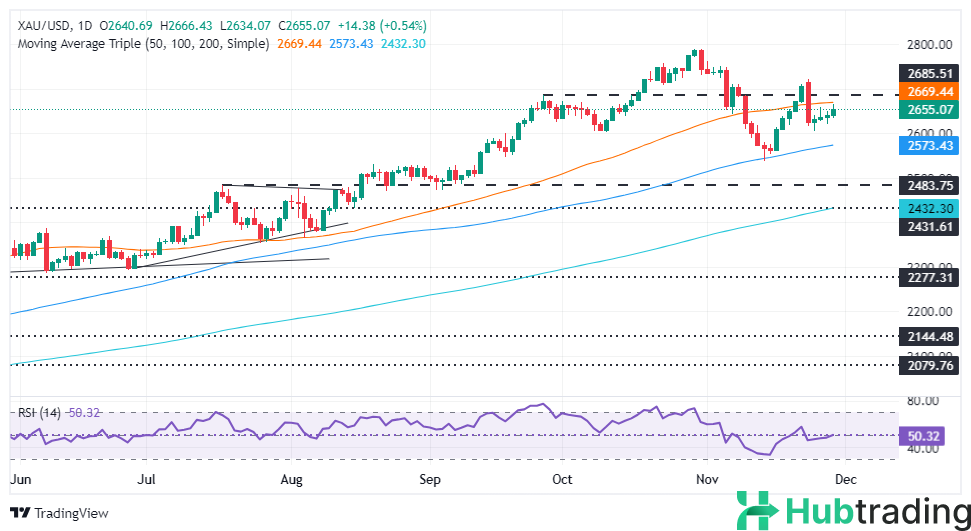- Gold rises 0.67% in the late session, remaining above $2,600 due to geopolitical tensions despite monthly declines.
- Heightened conflicts in Russia-Ukraine and the Middle East reinforce gold’s status as a safe-haven asset.
- Growing market anticipation of a 25 bps Fed rate cut in December strengthens bullion’s short-term outlook.
Gold prices climbed 0.67% during late trading on Friday in the North American session, closing at $2,652 after touching a daily low of $2,634. Despite this rebound, the metal remains on track for a monthly loss exceeding 3%, fluctuating around $2,600 as geopolitical risks continue to drive market sentiment.
Tensions eased slightly in the Middle East following a ceasefire agreement between Israel and Lebanon, though both sides have accused each other of violating the truce. However, tensions resurfaced after Sky News Arabia reported that the Israeli army conducted an airstrike on a Hezbollah mobile rocket platform in southern Lebanon.
Meanwhile, the ongoing escalation of the Russia-Ukraine conflict is expected to keep gold supported. This week, Russia intensified its attacks on Ukraine’s energy infrastructure and threatened ballistic missile strikes in response to U.S. and U.K. missile deployments within Russian territory.
In November, bullion prices faced pressure following U.S. President-elect Donald Trump’s victory on November 5. His proposed policies, including tariffs and tax cuts, are seen as inflationary, boosting the U.S. dollar, which is set to end the month with gains of over 2% according to the U.S. Dollar Index (DXY). Concerns over expansionary fiscal policies under the new administration could limit the Federal Reserve’s capacity to continue cutting interest rates.
The market received a boost last week after the announcement of Scott Bessent as the next Treasury Secretary. Known for his market-friendly stance, Bessent’s appointment eased concerns over Trump’s potential trade policies, supporting gold prices.
Investor optimism remains high for a 25 basis point Fed rate cut at the December meeting, with the CME FedWatch Tool indicating a 66% probability of such a move.
Daily Market Digest: Gold Supported by Declining U.S. Real Yields
- Gold prices rebounded as U.S. real yields fell seven basis points to 1.92%.
- The U.S. 10-year Treasury yield dropped six basis points, settling at 4.182%.
- The U.S. Dollar Index (DXY) slipped 0.37% to 105.75, though it remains on track for a monthly gain of 1.79%.
- Strong U.S. GDP and Core PCE Price Index data suggest the economy remains resilient, potentially prompting a pause in the Fed’s easing cycle.
- Despite this, Fed officials appear inclined toward further rate cuts in December, though they have adopted a cautious stance, leaving room for a potential pause.
- December fed funds rate futures indicate expectations of 24 basis points of easing by the end of 2024, according to the Chicago Board of Trade.
Technical Outlook: Gold Gains, But Stays Below Key Resistance
Gold prices are trending higher but remain constrained between the 50-day SMA at $2,668 and the 100-day SMA at $2,572. A break above the 50-day SMA could pave the way for a test of $2,700. Further upside could see resistance at $2,750, with the all-time high of $2,790 as the next target.
Conversely, a drop below $2,600 could lead to a retest of the 100-day SMA, with $2,536, the November 14 swing low, serving as a key support level.






